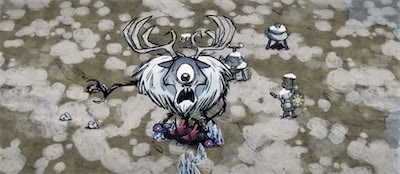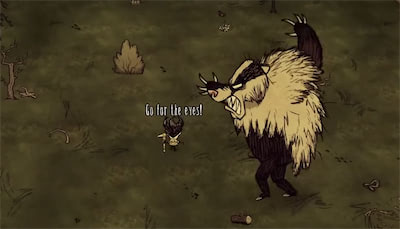Key Findings
The seasonal giants in Don’t Starve and its DLC Reign of Giants are pivotal challenges tied to specific seasons. Deerclops (winter), Moose/Goose (spring), and Bearger (autumn) each have unique spawn triggers, behaviors, and rewards. Their appearances are governed by in-game time, seasonal progression, and RNG mechanics, with strategies varying significantly between solo and multiplayer modes.
Seasonal Giant Spawn Mechanics
1. Deerclops (Winter Giant)
Spawn Window:
- Deerclops spawns in the final 5 days of winter, typically between days 29–31 in the first winter.
- In Don’t Starve Together (DST), spawn timing is more predictable (default: day 30.8), while solo Don’t Starve uses a 67% chance per winter.
Behavior:
- Targets player-built structures and emits a sanity-draining aura.
- Requires preparation: log suits, football helmets, and ham bats for tanking.

Post-Spawn Dynamics:
- Death grants the Deerclops Eyeball, essential for crafting the Eyebrella (critical for spring survival).
- Failure to kill Deerclops risks overlapping with Moose/Goose in spring.
2. Moose/Goose (Spring Giant)
Spawn Window:
- Appears early in spring, often 5 days after Deerclops’ death.
- Lays eggs that hatch hostile Moslings if not destroyed.
Behavior:
- Aggressive when threatened; attacks with AoE ground slams.
- Rewards Down Feathers for weather-proof clothing and luxury fans.

Caption: Moose/Goose laying eggs, which can hatch into hostile Moslings if not managed properly.
Strategic Considerations:
- Players must balance Deerclops cleanup with spring preparation (e.g., rain gear).
3. Bearger (Autumn Giant)
Spawn Window:
- First appears in the second autumn (day 70+) and returns every subsequent autumn.
- Does not spawn during the initial autumn of a new game.
Behavior:
- Non-aggressive unless provoked; prioritizes eating honey-based foods.
- Can be exploited to mass-chop trees or mine rocks.

Caption: Bearger, the autumn giant, prioritizing honey-based foods, can be utilized for resource gathering.
Utility:
- Drops Thick Fur for insulation gear and Bearger Claw for decorative structures.
Spawn Mechanics Across Game Modes
Solo Don’t Starve vs. Don’t Starve Together
- Solo: Giants have probabilistic spawns (e.g., Deerclops: 67% chance). Early seasons may lack bosses, but spawn likelihood increases over time.
- DST: Giants have fixed spawn timers (e.g., Deerclops at day 30.8) but retain seasonal dependencies.
Common Issues:
- Giants may fail to spawn if players frequently enter/exit caves or use mods altering world generation.
- Console commands like c_spawn("deerclops") allow manual spawning for testing.
Advanced Strategies and Modifications
1. Exploiting Environmental Hazards
- Tree Guards: Lure Deerclops into dense forests to spawn Tree Guards, which deal significant damage.
- Swamp Tentacles: Redirect giants to swamp biomes for automated kills via tentacle spikes.
2. Mod Support
- "Time Your Own Boss": Adjusts spawn frequency and seasonal triggers.
- "Global Positions": Coordinates multiplayer efforts to track giant movements.
3. Sanity Management
- Deerclops’ Sanity Drain: Combat with Jerky, Tam o’ Shanter, or Cooked Green Caps to stabilize sanity during fights.

Caption: Items like Jerky and Tam o' Shanter that help manage sanity during encounters with Deerclops.
Conclusion
Surviving seasonal giants requires meticulous preparation, adaptive strategies, and understanding of spawn mechanics. While Deerclops demands winter-ready combat gear, Moose/Goose and Bearger necessitate seasonal-specific countermeasures. The interplay between RNG, environmental exploitation, and mod customization ensures each playthrough remains dynamic, rewarding players who master the game’s punishing yet satisfying survival loop.
Recommendations:
- Prioritize Eyebrella crafting post-Deerclops for spring immunity.
- Use Bearger for efficient resource farming in late-game autumns.
- Experiment with mods like Geometric Placement for optimized base layouts against giant raids.